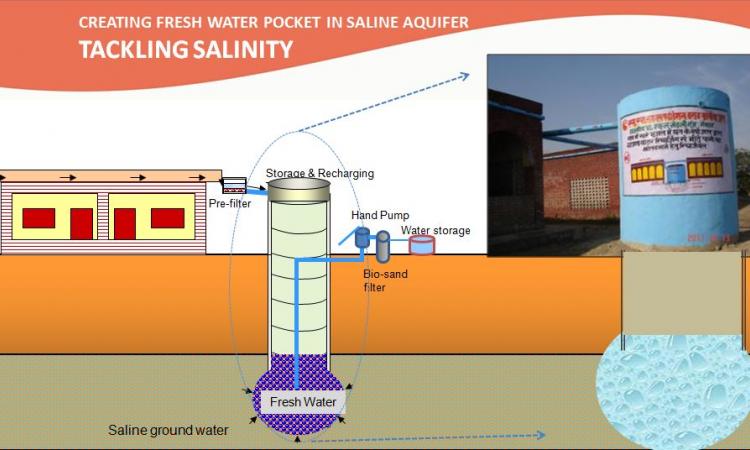
What is the exact problem as regards groundwater salinity, fluoride and water scarcity in Mewat, Haryana? Is the area underlain with saline groundwater aquifers? What is the status of surface water in the area? Can it not reduce dependence on groundwater?
Mewat has a dual problem of saline groundwater and erratic government water supply. There is no perennial surface water, and 78 percent of the district has saline groundwater. Salinity is very high, so there is no use of this resource. The salinity increases with depth and even fresh groundwater is underlain with saline groundwater. Over-extraction of fresh groundwater to feed saline areas is also causing encroachment of fresh groundwater areas by saline ones. There are few ponds used by cattle, and other used for domestic purposes but most of these surface water sources are seasonal. Therefore, in peak demand season these ponds dry up.
How does the water situation impact the people of Mewat?
It impacts the people of Mewat on social, economic and environmental fronts. Most of the people living in saline groundwater areas have to buy water and many of them have to walk long distances each day to fetch water to meet their daily requirements. This problem is further compounded by poor hygiene and sanitation leading to chronic health issues especially among women due to lack of potable water. Skeletal problems, skin allergies and urinary tract infections are common diseases prevalent in the district.
Due to water scarcity, there exists an unending water conflict among residents. Informal water markets are on the rise and the quality of water is not guaranteed. Most of the households in saline groundwater areas buy water from tankers and spend around Rs. 1000 per month.
The region also continues to depend on rainfed agriculture due to lack of irrigation sources. Despite harsh climatic conditions, agriculture is the major livelihood option. Agricultural productivity is low and this will escalate in the coming days in the backdrop of changing climate. However, in developed regions of the district, farmers having access to fresh water are able to produce high value crops, which are of demand in neighbouring Delhi. On the contrary, people living in saline regions are backward and are dependent on informal credit. Several of them have migrated to work in nearby states. This has become a new phenomenon in recent times. By and large, the major reason of poor economy of the district is water scarcity. Because of salinity in groundwater and the presence of shallow aquifers, the tree density is very low in the region. This condition clubbed with the rocky terrain of the Aravalli range raises the temperature during peak summers.
The difference between maximum and minimum temperature is decreasing over the years. Because of this phenomenon, crop cycle is severely affected thereby affecting nutritional components of the crop and threatening the nutritional security of the people here.
Tell us about the work of Sehgal Foundation in strengthening community-led development initiatives especially water management initiatives in Mewat. How does it train the people and their Development Committees to effectively manage water resource?
Water management is a flagship program of the Sehgal Foundation. We believe in community-led development initiatives. We sensitise rural communities about the prevailing water issues through regular interactions. We build their capacity to understand the science behind our intervention, and on how to take care of the rainwater harvesting structures that are built in the villages. All our interventions are carried out with active participation of the communities right from the start. We seek consent and cooperation of the community before we start working in any village.
An approval letter from a local authority, community contribution, operation and maintenance of the structure created in the post project completion period remain as prime focus for us.
Is Sehgal Foundation working on rainwater harvesting systems for schools and private buildings? What has your experience been?
Sehgal Foundation has been working on rainwater harvesting systems in schools and other public buildings. These systems are working fine and helping conserve water and are the only source of potable water in these schools.
Please tell us more about the innovative solutions devised by Sehgal Foundation to provide potable water. How is your solution different from traditional recharging methods? Can it be replicated elsewhere and under what conditions? Can it be adapted for deeper saline aquifers?
To tackle the problem of groundwater salinity, we have developed and constructed innovative rainwater harvesting models for the ‘creation of sweet water pockets within a saline aquifer’. In this model, the structure (recharge well) stores and recharges 'sweet' rainwater below the groundwater table, as a freshwater pocket within a saline aquifer (groundwater zone).
This is achieved by recharging collected rooftop rainwater below the water table, with gravity-induced hydrostatic pressure. For this, the recharge well is sunk to a depth lower than the existing groundwater level and raised to an above ground height to gain additional hydrostatic pressure in shallow aquifer conditions. As rainwater enters this well, due to hydrostatic pressure rain water pushes the existing saline water aside and forms a pocket of freshwater within the saline aquifer. Later, this sweet water is extracted with a hand pump. The water passes through a biosand filter that removes physical, suspended, and biological contaminants and is accessed through water taps at the school. The model is environment friendly as the system requires no use of chemicals or energy.
Yes this model can be replicated in coastal areas, areas with inland salinity, and deep and shallow aquifer regions with slight modifications.
/articles/tackling-water-salinity-mewat-haryana